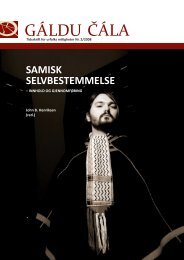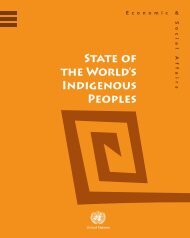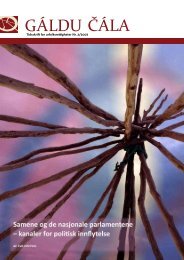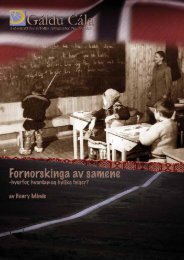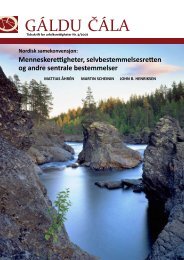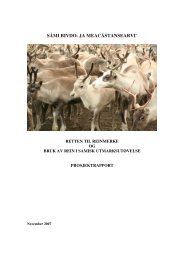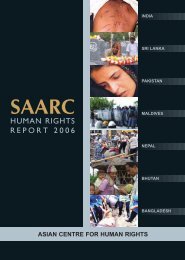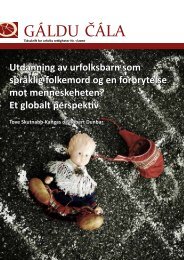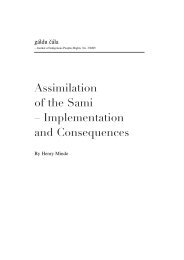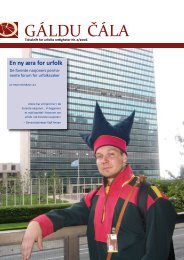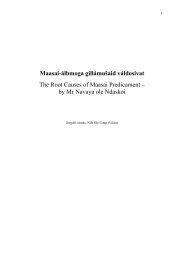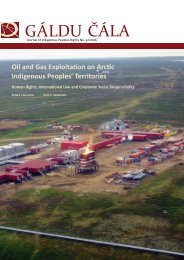The Roots Causes of Maasai Predicament, By Navaya ole Ndaskoi
The Roots Causes of Maasai Predicament, By Navaya ole Ndaskoi
The Roots Causes of Maasai Predicament, By Navaya ole Ndaskoi
You also want an ePaper? Increase the reach of your titles
YUMPU automatically turns print PDFs into web optimized ePapers that Google loves.
<strong>The</strong> <strong>Roots</strong> <strong>Causes</strong> <strong>of</strong> <strong>Maasai</strong> <strong>Predicament</strong><br />
<strong>By</strong> <strong>Navaya</strong> <strong>ole</strong> <strong>Ndaskoi</strong>
1. INTRODUCTION............................................................................................................................... 3<br />
2. MAASAI .............................................................................................................................................. 4<br />
3. LAND ALIENATION ........................................................................................................................ 7<br />
4. THE GERMANS VERSION............................................................................................................ 10<br />
5. FALSE PROMISES.......................................................................................................................... 11<br />
6. THE BEAUTIFUL ONES ARE NOT YET BORN ....................................................................... 13<br />
7. A COMPLEX SITUATION.............................................................................................................15<br />
8. THE NATIONAL INCOME FACTOR .......................................................................................... 16<br />
9. WILL THEY SURVIVE ................................................................................................................ 17<br />
REFERENCE ............................................................................................................................................. 19<br />
2
1. Introduction<br />
On two different occasions between August 2004 and January 2005 the <strong>Maasai</strong><br />
pastoralists <strong>of</strong> Kenya surfaced in the mass media, both print and electronic.<br />
August 15, 2004 was exactly 100 years after the signing <strong>of</strong> the controversial agreement<br />
between the British Government and the <strong>Maasai</strong> which allowed British settlers to allocate<br />
land to themselves in Kenya at the expense <strong>of</strong> the <strong>Maasai</strong>. Claiming that the agreement<br />
had expired, the <strong>Maasai</strong> demonstrated across the Rift Valley and in the capital <strong>of</strong> Kenya,<br />
Nairobi. <strong>The</strong>y also invaded privately own ranches in Laikipia District.<br />
In the bid to protect private property and maintain peace in the country, the Government<br />
reacted by arresting several <strong>Maasai</strong>. In the process the police, reportedly, killed a <strong>Maasai</strong>.<br />
Secondly, a simmering conflict between <strong>Maasai</strong> pastoralists and Kikuyu farmers erupted<br />
in January 2005 in Mai Mahiu and Mandera locations. In this conflict at least 40 people<br />
lost their precious lives, dozens were serious injured and hundreds fled their homes.<br />
Properties worth millions <strong>of</strong> dollars were destroyed (<strong>The</strong> Standard, February 14, 2005).<br />
<strong>The</strong>se two incidents <strong>of</strong> conflicts are principally based on landedresources, especially land<br />
and water. This paper is an attempt to describe the historical background <strong>of</strong> the conflicts<br />
and their implications to the survival <strong>of</strong> the <strong>Maasai</strong> in both Kenya and Tanzania.<br />
Traditionally the <strong>Maasai</strong> were pastoralists raising mainly cattle but also small stock such<br />
as goats and sheep. Given their t<strong>ole</strong>rant attitude towards wildlife, they lived side by side<br />
with wildlife. When Europeans came to Africa all <strong>of</strong> them were, literally, carrying guns.<br />
A hunting spree was sustained for decades. <strong>The</strong>y nearly wiped out wildlife. Later, some<br />
wise colonists advocated wildlife conservation. This proved to mean appropriation <strong>of</strong><br />
<strong>Maasai</strong> rangelands to create national parks and game reserves (Parkipuny, 1991).<br />
Wildlife conservation was, however, not the only source <strong>of</strong> <strong>Maasai</strong> predicament. Largescale<br />
settler agriculture especially in Kenya was another. Beside, British colonial<br />
Government considered the <strong>Maasai</strong> way <strong>of</strong> life as primitive and was determined to deal<br />
with it as such (Keiwua, 2002). In effect other forms <strong>of</strong> land uses were encouraged at the<br />
expense <strong>of</strong> <strong>Maasai</strong> pastoralism which was condemned as ‘primitive.’<br />
After ‘independence’ in both Kenya and Tanganyika 1 the <strong>Maasai</strong> dilemma surprisingly<br />
increased instead <strong>of</strong> diminishing. <strong>The</strong> Governments in the two countries retained the<br />
colonial mentality against pastoralism (Fosbrooke, 1972). <strong>The</strong> so-called ‘national<br />
interest’ disarmed the <strong>Maasai</strong> <strong>of</strong> their land in Tanzania (Shivji, 1998). In Kenya,<br />
politicians, the rich, and British settlers as well as wildlife conservationists chopped <strong>of</strong>f<br />
large chunks <strong>of</strong> what used to be the <strong>Maasai</strong> territory (Rutten, 1992).<br />
So much so that one <strong>of</strong>ten hears the question: ‘Will the <strong>Maasai</strong> survive or perish’ This<br />
article answers the question focusing on the suffering <strong>of</strong> the <strong>Maasai</strong> in Kenya and<br />
Tanzania. This does not mean that others have not suffered in the two countries. To be<br />
sure, there are volumes and volumes <strong>of</strong> books unearthing countless sickening sufferings<br />
in the two countries. But the <strong>Maasai</strong> suffering has rarely been acknowledged.<br />
1 Tanganyika ‘united’ with Zanzibar to form Tanzania in April 1964.<br />
3
2. <strong>Maasai</strong><br />
Western historians and anthropologists have, seemingly, deliberately, ignored the <strong>Maasai</strong><br />
point <strong>of</strong> view and have written <strong>Maasai</strong> history wrongly.<br />
This part aims to correct, in summary, the myths about the <strong>Maasai</strong>. It is for the people<br />
who wish to know the <strong>Maasai</strong>, not as ‘a powerful tribe <strong>of</strong> arrogant fierce savages’ or ‘a<br />
curious attractive group that performs ancient war dances while dressed up in outlandish<br />
attire,’ but as a people with a soul, a history, and a future in a remarkable sort <strong>of</strong> way.<br />
European writers corrupted the word <strong>Maasai</strong> to Masai. Sadly, many <strong>of</strong> contemporary<br />
African writers; go on with this error. Do the <strong>Maasai</strong> originate from Egypt According to<br />
historians they are coming from ‘far away in the North.’ But exactly where the origin <strong>of</strong><br />
the <strong>Maasai</strong> is is something no living person today can honestly pr<strong>of</strong>ess to know (Sokoine,<br />
1981). <strong>The</strong> wide knowledge <strong>of</strong> the <strong>Maasai</strong>, extending far beyond the borders <strong>of</strong> East<br />
Africa is ‘too <strong>of</strong>ten a distorted image and an unduly romanticised one’ (Parkipuny, 1975).<br />
Few tribes have attracted as much attention as the <strong>Maasai</strong>. Historians and anthropologists<br />
have written volumes and volumes about the <strong>Maasai</strong>, yet they have failed to puncture the<br />
image created by more romantically inclined observers (Adams & McShane, 1992). How<br />
did the strange writing about the <strong>Maasai</strong> begin <strong>The</strong> classic colonial modus operandi was<br />
to first commence by exploration <strong>of</strong> the lands to be st<strong>ole</strong>n. <strong>The</strong> likes <strong>of</strong> Dr David<br />
Livingstone and Henry Morton Stanley came to Africa. <strong>The</strong>y returned from Africa with<br />
weird stories <strong>of</strong> ‘savages capering around boiling pots <strong>of</strong> human flesh.’<br />
<strong>The</strong>se were followed by missionaries who introduced Christianity to the <strong>Maasai</strong>. Two<br />
Germans, Dr. Ludwing Krapf and Rev. John Rebman members <strong>of</strong> the Church Missionary<br />
Society are believe to be the first Europeans to contact the <strong>Maasai</strong> in the late 1840s.<br />
Krapf published a book titled Travels, Researches and Missionary Labours in 1860<br />
which probably contains the first written description <strong>of</strong> the <strong>Maasai</strong>. He wrote:<br />
<strong>The</strong>y live entirely on milk, butter, honey and the meat <strong>of</strong> black [sic!] cattle, goats and<br />
sheep...they are dreaded as warriors, laying all waste with fire and sword, so that the weaker<br />
tribes do not venture to resist them in the open field, but leave them in possession <strong>of</strong> their herds,<br />
and seek only to save themselves by the quickest possible flight.<br />
<strong>The</strong>n the British Royal Geographic Society sent Joseph Thomson to East Africa. In his<br />
book Thomson described his first encounter with the <strong>Maasai</strong> in these words: ‘We soon set<br />
our eyes upon the dreaded warriors that had so long been the subject <strong>of</strong> my waking<br />
dreams, and I could not but involuntarily exclaim, “What splendid fellows” as I surveyed<br />
a band <strong>of</strong> the most peculiar race <strong>of</strong> men to be found in Africa’ (Thomson, 1885). Isak<br />
Dinesen was a fervent admirer <strong>of</strong> the <strong>Maasai</strong>. She writes, ‘A <strong>Maasai</strong> warrior is a fine<br />
sight.’ In effect Dinesen played a r<strong>ole</strong> in carrying the stereotype about the <strong>Maasai</strong> to the<br />
extremes. In her book titled Out <strong>of</strong> Africa published in 1972 she said:<br />
Those young men have, to the utmost extent, that particular form <strong>of</strong> intelligence which we call<br />
chic; daring, and wildly fantastical as they seem, they are still unswervingly true to their own<br />
nature, and to an imminent ideal. <strong>The</strong>ir style is not an assumed manner, nor an imitation <strong>of</strong> a<br />
foreign perfection; it has grown from the inside, and is an expression <strong>of</strong> the race and its history,<br />
and…weapons and finery are as much a part <strong>of</strong> their being as are a stag’s antlers.<br />
4
So effective has been this portrayal that many contemporary African writers still view the<br />
<strong>Maasai</strong> through this jaundiced prism. In his No More Lies about Africa, for example,<br />
Musamaali Nangoli joins the cult by navigating far away from the very title <strong>of</strong> his book:<br />
For the Masai…a young boy <strong>of</strong> about sixteen c<strong>of</strong>fee seasons throws himself into the bush barehanded<br />
and kills a lion in order to become a man (Nangoli, 2002:59).<br />
With the possible exception <strong>of</strong> the Biblical Samson a human being cannot kill a lion<br />
bare-handed. It is important however to explain briefly the <strong>Maasai</strong> social set-up.<br />
<strong>Maasai</strong> means speakers <strong>of</strong> Maa dialects. <strong>The</strong>re are several sub-sections that speak Maa<br />
(MAA, 2004). Some whose remnants still exist today are IlPurko, ISalei, IlKisonko,<br />
ILumbwa, ISikirari, IlKaputie, ILoodokilani, ILarusa, IlDamat, IlMatapato, ILaitayiok,<br />
IlLoitai, ISiria, IlUasin Nkishu, IlDalalekutuk, IlKeekonyokie, IlKankere, IlMoitanik and<br />
many others. Some have been ‘wiped out’ in tribal conflicts. For example Ildikiri, Ilkoli,<br />
Iloogol-ala, Ilaikipiak and Ilosekelai sub-sections have been ‘eliminated’ (Kulet, 1972).<br />
<strong>The</strong>re are several clans, injomiei, in the <strong>Maasai</strong> society. <strong>The</strong>re are two major clans <strong>of</strong><br />
society. One is Oodo Mong’i, Red Cow and the other is Orok Kiteng, Black Cow. Within<br />
each clan, there are sub-clans, ilpaasheta. Sub-clans in Oodo Mong’i clan are Ilm<strong>ole</strong>lian,<br />
Ilmakesen and Iltarosero while Ilaiser and Ilukumai are the sub-clans in Orok Kiteng<br />
clan. It is noteworthy that members <strong>of</strong> the same clan respected one another in a brotherly<br />
way. A man could not for example marry a woman <strong>of</strong> his clan because the community<br />
considered her his sister - a great abomination in the eyes <strong>of</strong> the <strong>Maasai</strong>.<br />
<strong>The</strong> <strong>Maasai</strong> men are organised by a system based on age set, olporo. Under this system<br />
all the boys, on attaining the age <strong>of</strong> sixteen or thereabouts, are circumcised and accepted<br />
into a particular age-set, a unit possessing a single name and a sense <strong>of</strong> unity. <strong>The</strong>re<br />
follows the happiest time <strong>of</strong> a <strong>Maasai</strong> man’s life. <strong>The</strong> warrior is not only expected to<br />
express the best <strong>of</strong> human virtues, but also to feel that he is inferior to no one.<br />
Romantically inclined writers talk <strong>of</strong> the ‘military power <strong>of</strong> the Masai.’ But that suggests<br />
an organised military machine under a single command implementing a national policy.<br />
No such ‘nation wide’ co-ordination existed. <strong>The</strong>re is not, nor did there ever exist, a<br />
single ‘chief’ <strong>of</strong> the <strong>Maasai</strong>, at the apex <strong>of</strong> the pyramid (Parkipuny, 1975) 2 .<br />
Before the introduction <strong>of</strong> a unified national leadership system hinged on the<br />
organisational structure <strong>of</strong> western societies, <strong>Maasai</strong>, like other societies in Africa, had its<br />
own system <strong>of</strong> organisation and leadership. <strong>The</strong>re were no rulers but there were leaders.<br />
For every sub-tribe each age group had a leader, olaigwanani plural is ilaigwanak<br />
‘elected’ by the largest possible assembly <strong>of</strong> the members <strong>of</strong> the group. <strong>The</strong>re was also a<br />
deputy leader engopiro - plural is ingopir. Such leaders were ‘elected’ and functioned<br />
only in and through the youth age <strong>of</strong> the group, murano. Besides youth leaders there were<br />
also sub-tribal leaders. Again not rulers, but spokesmen. Same with their deputies. <strong>The</strong><br />
leadership functions <strong>of</strong> these spokesmen transcended the age group segmentation.<br />
Neither ilaigwanak nor any other person had the power to enforce judgement or order. It<br />
was the weight <strong>of</strong> public opinion which compelled the individuals to act as required (for a<br />
fuller account <strong>of</strong> this see Kulet, 1972). In 1933, the British enlisted the medicine men,<br />
2 <strong>The</strong> British and Germans confused Oloiboni to be the Chief. He was a medicine-man and rain-maker.<br />
Though his position enjoyed prestige in the <strong>Maasai</strong> society he could not claim any political authority.<br />
5
iloibonok, on the pay roll as ‘chiefs <strong>of</strong> the Masai’ hoping that at long last they had found<br />
the right agents for responsive indirect rule. But the British efforts were in vain. Though<br />
the medicine man position enjoyed prestige and influence in the society they could not<br />
claim any resemblance <strong>of</strong> tradition to wielding executive authority. In no time the <strong>Maasai</strong><br />
came out in protest over the manipulation and insisted that the medicine men should keep<br />
out, far way from leadership (Parkipuny, 1975:64).<br />
Contrary to the popular belief the <strong>Maasai</strong> do not live on a diet <strong>of</strong> milk and blood. True,<br />
the warriors consume these foods extensively, plus the meat eaten at the meat feasts held<br />
in special camps, ilpuli. <strong>The</strong> elders, women and young folk eat considerable amounts <strong>of</strong><br />
agricultural crops, cereals, beans, bananas and others. Warriors take these foods too. But<br />
they do it secretly as food not obtained from livestock is viewed as inferior (Ibid.). <strong>The</strong><br />
<strong>Maasai</strong> obtained these from the hill dwellers at barter markets at numerous points in the<br />
foothills where highlands and plains meet (Kivasis, 1953 & Hollis, 1905).<br />
<strong>Maasai</strong> lived a pastoral life and traded their cattle for the fruit and grain <strong>of</strong> their<br />
agricultural neighbours. <strong>The</strong>y are still condemned for maintaining ‘excessive numbers <strong>of</strong><br />
useless cattle that deprived wildlife <strong>of</strong> water and grazing’ (Rutten, 2002:4). <strong>The</strong><br />
Government thus reduces veterinary services to allow nature to assist in de-stocking<br />
(Mchome, 2002:106). In effect the ‘livestock industry has lost about $ 136 million over<br />
the past 14 years’ (<strong>The</strong> EastAfrican January 24, 2005). It must be remembered, however,<br />
that in the eyes <strong>of</strong> <strong>Maasai</strong> pastoralists there is nothing like ‘useless cattle.’<br />
Most <strong>of</strong> them mostly sell a fraction <strong>of</strong> their livestock. Even then its contribution to ‘the<br />
economy’ is comparatively substantial. In 2001, for example, the livestock sector earned<br />
the Government in Arusha Region TShs.16.7 billion (Nipashe September 29, 2001). This<br />
sum, however, does not capture the non-monetarised livestock contributions like<br />
consumption, manure and draught power. <strong>The</strong> contribution <strong>of</strong> the sector outstrips by far<br />
that <strong>of</strong> the wildlife-based tourism industry. All protected areas in the same year<br />
contributed, if much, not more than TShs.10 billion in Arusha in the same year (Business<br />
Times March 3, 2000). And the Government supports wildlife and tourism.<br />
Next the paper turns to the most controversial problem facing the <strong>Maasai</strong>.<br />
6
3. Land Alienation<br />
In the name <strong>of</strong> development the <strong>Maasai</strong> have lost a huge part <strong>of</strong> their ancestral land.<br />
Alienation <strong>of</strong> <strong>Maasai</strong> land for agriculture and for the interest <strong>of</strong> wildlife conservation is<br />
one <strong>of</strong> the main blights facing the <strong>Maasai</strong> in both Kenya and Tanzania.<br />
It is said <strong>Maasai</strong>land extends from Mkomazi through Upare to the southern foothills <strong>of</strong><br />
Mount Kilimanjaro and runs northward between Mount Kilimanjaro and Mount Meru,<br />
Olng’elata (Kivasis, 1953). To the West the <strong>Maasai</strong> took in the wh<strong>ole</strong> <strong>of</strong> <strong>Maasai</strong> Steppe<br />
extending southwards to include today known villages on the Handeni-Kondoa road,<br />
Swakini, Kijungu and Mgera. <strong>The</strong> extreme westerly limit is the West <strong>of</strong> the Serengeti<br />
(Fosbrooke, 1972). It is a large territory covering a total <strong>of</strong> 105,105 square kilometres.<br />
<strong>The</strong> Kenya/Tanzania border line cuts across <strong>Maasai</strong>land for kilometres stretching from<br />
West <strong>of</strong> Mara River to the eastern slopes <strong>of</strong> Kilimanjaro Mountain. During colonial time<br />
<strong>Maasai</strong>land was divided into four administrative Districts namely Narok and Kajiado in<br />
Kenya and Monduli and Kiteto in Tanzania (Parkipuny, 1975).<br />
<strong>The</strong> British came and condemned the <strong>Maasai</strong> for being wanderers who must be dealt with<br />
as such, virtually, to prevent them from ‘destroying the environment and wasting or<br />
under-utilising the land.’ Justice Moijo <strong>ole</strong> Keiwua notes with grave concerns:<br />
<strong>The</strong> British who came, saw and coveted the land disrupted communal land ownership. A hasty<br />
study <strong>of</strong> the <strong>Maasai</strong> was undertaken with equally hasty conclusions made. <strong>The</strong> rights <strong>of</strong> the<br />
<strong>Maasai</strong> to own their land had been watered down to mere grazing rights…Eliot cannot in<br />
fairness call the <strong>Maasai</strong> wanderers. Between the <strong>Maasai</strong> on their land, and the British who had<br />
wandered all the way from little England, who was a wanderer (Keiwua, 2002).<br />
In Africa, like elsewhere, at the dawn <strong>of</strong> the 20 th century the British used tricks and, more<br />
importantly, their military strength to alienate land to British settlers at expense <strong>of</strong> the<br />
local populations (Vambe, 1972). <strong>The</strong> British applied the same techniques to deprive the<br />
<strong>Maasai</strong> <strong>of</strong> their ancestral land (MAA, 2004). <strong>The</strong> problem is expressed well:<br />
<strong>The</strong> British tricked us! After we had been weakened by civil wars and droughts, they claimed<br />
that our Great Laibon, O’lonana, had signed an agreement in 1904 with His Majesty’s<br />
Commission for the East African Protectorate, leasing Kenya to the British. <strong>The</strong> <strong>Maasai</strong> would<br />
never have accepted such a lease! This would have confined us to an arid, dusty land <strong>of</strong><br />
thousands <strong>of</strong> miles where the threat <strong>of</strong> drought…is imminent (Saibull & Carr, 1981).<br />
He is referring to the so-called ‘Anglo-<strong>Maasai</strong> Agreements’ prepared by the British<br />
colonialists on August 10, 1904. That ‘agreement’ was signed on August 15, 1904<br />
between the British colonial Government and the <strong>Maasai</strong> in Nairobi, the present day<br />
capital <strong>of</strong> Kenya. <strong>The</strong> Governor, Sir Donald Stewart, represented the British while<br />
Olonana <strong>ole</strong> Mbatiany ‘represented’ the <strong>Maasai</strong>. <strong>The</strong> ‘agreement’ stipulates that:<br />
<strong>The</strong> Masai leaders ‘<strong>of</strong> our own free will’, decided that it is for our best interests to remove our<br />
people, flocks, and herds into definite reservations away from the railway line, and away from<br />
any land that may be thrown open to European settlement (New York Times August 25,2004).<br />
Olonana had no mandate to sign away the <strong>Maasai</strong> land. He was neither <strong>Maasai</strong> leader nor<br />
representative. He was a mere medicine man. Commenting on the ‘agreements’ Justice<br />
Nzamba Kitonga, former Chairman <strong>of</strong> the Law Society <strong>of</strong> Kenya, argues:<br />
In these circumstances, you do not need a lawyer to tell you that the so called Anglo-<strong>Maasai</strong> land<br />
agreement was a gigantic fraud and has no binding effect upon the <strong>Maasai</strong>, the government <strong>of</strong><br />
7
the Republic <strong>of</strong> Kenya or any other person. And the government knows all this (<strong>The</strong> EastAfrican<br />
September 6, 2004).<br />
<strong>The</strong> <strong>Maasai</strong> on their part did not, and had no reason to, abide to a null and void<br />
agreement. To the <strong>Maasai</strong>, land was theirs and not a property to be owned like a horse by<br />
individuals. Any lease was, and still is, a foreign concept to them. <strong>The</strong>y thus ignored it.<br />
<strong>The</strong> British effort was therefore in vain. <strong>The</strong> British colonialists came up with yet another<br />
‘agreement’ signed by the same sometimes in 1911. <strong>The</strong> <strong>Maasai</strong> reaction was immediate.<br />
In 1912 a group <strong>of</strong> <strong>Maasai</strong>, led by Mr Murket <strong>ole</strong> Nchoko, filed a suit in the court <strong>of</strong><br />
Mombasa seeking to nullify ‘the agreement.’ <strong>The</strong> <strong>Maasai</strong> basic contention was that the<br />
elders who signed the agreement had no authority to ‘alienate the interest <strong>of</strong> minors and<br />
unborn children.’ But the case and a subsequent appeal were dismissed as the court ruled<br />
the agreement was actually a ‘treaty’ between two ‘states’ and that the court had no<br />
jurisdiction to handle such cases. <strong>The</strong> <strong>Maasai</strong> did not give up. <strong>The</strong>y planned to lodge a<br />
final appeal in London. This was nipped in the bud when the protectorate quarantined the<br />
<strong>Maasai</strong> cattle when it learned <strong>of</strong> efforts to sell cattle and raise money to file the case (<strong>The</strong><br />
EastAfrican August 16, 2004). It was clear that the <strong>Maasai</strong> were losers.<br />
<strong>The</strong> British told them to stay out, away from what used to be their land. <strong>The</strong>y should stay<br />
far from the then Uganda Railway. <strong>The</strong> British equally robbed other Kenyans. <strong>The</strong>ir<br />
misadventure in Nandiland is responsible for the famous Nandi Resistance 1850-97. Only<br />
when the Nandi were defeated, not easily, did the British take their land. Kikuyu, Embu,<br />
Meru, Kamba and other Kenyans were also deprived <strong>of</strong> their land. That was the rule<br />
wherever the British saw attractive land in Africa. <strong>The</strong>y grabbed it. Everything grows on<br />
and <strong>of</strong>f the land. Without land no life. <strong>The</strong> First and Second World Wars plus their<br />
consequences weakened the British. <strong>The</strong> turmoil between imperialists was itself<br />
development by contradiction. On the other hand Africans who were in the battlefields<br />
came home with arms and more military skills, the armed struggle against British rule<br />
was just around the corner. To survive the looming war the British had to live on<br />
Commissions. In 1932 they formulated the infamous Carter Land Commission.<br />
That Commission did not return any land to any Kenyan. Mau Mau, the militant African<br />
nationalist movement became a full-scale fight; <strong>The</strong> Mau Mau War 1952-6. It advocated<br />
vi<strong>ole</strong>nt resistance to British domination in Kenya (Maloba, 1998). It was especially<br />
associated with the ritual oaths employed by leaders <strong>of</strong> the Kikuyu Central Association to<br />
promote unity in the independence movement. In October 1952, after a campaign <strong>of</strong><br />
sabotage and assassination attributed to Mau Mau fighters, the British Kenya<br />
Government declared a state <strong>of</strong> emergency. It began four years <strong>of</strong> military operations<br />
against Mau Mau fighters. <strong>By</strong> the end <strong>of</strong> 1956, more than 11,000 fighters had been killed<br />
in that war, along with about 100 Europeans and 2,000 African loyalists. More than<br />
20,000 other Africans were put into detention camps, where intensive efforts were made<br />
to convert them to the political views <strong>of</strong> the colonial Government, to abandon their<br />
nationalist aspirations. Despite these actions, Mau Mau resistance spearheaded the Kenya<br />
independence movement under Jomo Kenyatta (visit onwar.com).<br />
<strong>The</strong> British established the R.J.M. Swynnerton Commission in 1954. Swynnerton’s<br />
Report on How to Intensify the Development <strong>of</strong> African Agriculture in Kenya was aimed<br />
at the privatisation <strong>of</strong> land ownership through the displacement <strong>of</strong> Indigenous Land<br />
Tenure systems and replacing it with a system that entrenched private property rights<br />
8
along the lines <strong>of</strong> the English Land Law. <strong>The</strong> Swynnerton Plan, adopted in 1954,<br />
advocated individual land tenure and export cash crop production for Africans. <strong>The</strong><br />
landless agricultural population was thus compelled to encroach on and overcrowd<br />
<strong>Maasai</strong> land.<br />
In the meantime the British saw clearly that they would never defeat the Mau Mau<br />
fighters. Only then did they succumb to ‘dialogue’ which means the Lancaster<br />
Constitution ‘talks’ <strong>of</strong> 1962. <strong>The</strong> war ended but the <strong>Maasai</strong> were marginalised. <strong>The</strong> leases<br />
giving British settlers the <strong>Maasai</strong> land, according to former Kajiado North MP John<br />
Keen, were premised on manipulation. This fact, Keen says, ‘has always been protested<br />
by the community leaders who walked out <strong>of</strong> Lancaster Constitution talks…over the<br />
issue. <strong>The</strong> <strong>Maasai</strong> leaders always walked out <strong>of</strong> the talks to protest the dubious agreement<br />
leasing their land to British settlers’ (<strong>The</strong> Standard August 30, 2004).<br />
Meanwhile in the Lancaster Constitution ‘talks’ the British succeeded in assuring that the<br />
African leaders who took over were going to protect the British interests. <strong>The</strong>se were<br />
written in the new Constitutions (Mohiddin, 1981). An agreement was reached on the<br />
white highlands, the best land that was expropriated from Africans, in which select<br />
Africans would be permitted to buy some <strong>of</strong> the land there with money lent to them from<br />
the British Government in London (Gutto, 1981:54-5). <strong>The</strong> new leaders, including<br />
Kenyatta, who were once extremely adamant about the return <strong>of</strong> these lands, had no<br />
objections (Ake, 1986). Independence in Kenya, like elsewhere in Africa, was to be no<br />
more than a gradual Africanisation <strong>of</strong> the colonial administration (Fanon, 1967).<br />
On December 12, 1963 Kenya finally became ‘independent.’ Kenyatta became the first<br />
President <strong>of</strong> Kenya under Kenya African National Union, today better known as KANU.<br />
KANU ruled Kenya for nearly 40 years. Daniel T. Arap Moi assumed power following<br />
the sudden death <strong>of</strong> Kenyatta in 1978. What about the land question It was never solved.<br />
9
4. <strong>The</strong> Germans Version<br />
In Tanganyika, the Germans for their part pursued a similar policy and attempted to<br />
confine the <strong>Maasai</strong> to the South and East <strong>of</strong> ‘the Great North Road.’ <strong>The</strong>y permitted the<br />
brothers Adolf and Friedrich Siedentopf to grab land in the Ngorongoro Crater and set<br />
aside the Serengeti for sheep farming (Parkipuny, 1975). <strong>The</strong> Siedentopfs tried<br />
unsuccessfully to exterminate wildlife to give room for two farms in the Crater (Grzimek,<br />
1960). Germans appropriated numerous farms around Mount Kilimanjaro and Meru. <strong>The</strong><br />
<strong>Maasai</strong> sub-tribe, Ilkisonko from the plains <strong>of</strong> these mountains moved to Ngorongoro.<br />
<strong>The</strong> <strong>Maasai</strong> had to lose mountainous areas first. This is because, naturally and for very<br />
good reasons, they prefer to live on the plains rather than in the highlands. <strong>Maasai</strong>,<br />
though sentimentally attached to the highlands, prefers life on the plains. Cattle thrive<br />
better and fatten quicker there. Humans are less liable to bronchial trouble than in the<br />
damp, misty, highlands, and because the waters are temporary, malaria usually presents<br />
little problems. It is possible that Germans found few or no <strong>Maasai</strong> on the highlands, thus<br />
justifying land grabbing as the land was supposedly idle or underused or wasted.<br />
<strong>The</strong> ‘Sanya corridor’ comprised a series <strong>of</strong> German demarcated farms and ranches, such<br />
as the present day West Kilimanjaro ranch, which the British held back from re-alienation<br />
so as to allow the <strong>Maasai</strong> to the North and West <strong>of</strong> Kilimanjaro and Meru to cross over<br />
the saddle between the two mountains and utilise the grazing <strong>of</strong> the Sanya Plains and<br />
beyond. As part <strong>of</strong> boundary readjustments, which led to the notorious Meru land case,<br />
the <strong>Maasai</strong> lost this corridor and much <strong>of</strong> the Sanya Plains as well (Fosbrooke, 1972). In<br />
1955 Lolchoro area South <strong>of</strong> Arusha town was the scene <strong>of</strong> large-scale alienation.<br />
On the foothills <strong>of</strong> Mount Munduli where there is the comparative favourable climate, the<br />
colonialists appropriated huge lands for themselves. <strong>The</strong> notorious Monduli C<strong>of</strong>fee Estate<br />
was established in 1931 though it existed before that year. Frank Anderson, an Australian<br />
criminal, annexed for himself the land that was to become Rasha Rasha C<strong>of</strong>fee Estate.<br />
Mr. Joseph Benesta owned another massive Tarosero C<strong>of</strong>fee Estate whose remains can<br />
still be seen at the West <strong>of</strong> the present day headquarters <strong>of</strong> Monduli District.<br />
All told, Greek and Boer settlers attempted to establish wheat and sisal plantations in<br />
either side <strong>of</strong> the present day Arusha-Dodoma Road as far as the eye can see. However<br />
these farms did not succeed. But the plains still bear the names, Inganui, places <strong>of</strong> wheat<br />
and Irkatan, places <strong>of</strong> sisal in Maa language. German settlers went as far as Lepurko and<br />
Losimingori where they established ranches. <strong>The</strong> present day Manyara ranch was<br />
established during or around that time.<br />
When the Germans were defeated in the First World War, according to the Versailles<br />
Treaty, they had to nominally lose their territories abroad. That was how Britain came to<br />
take over Tanganyika in the early 1920s. <strong>The</strong> war-weakened British could not start<br />
massive settler plantations in Tanganyika (Shivji, 1998). It opted for the ‘indirect rule’<br />
policy which consisted <strong>of</strong> a campaign to settle peasants in <strong>Maasai</strong>land (Parkipuny, 1975).<br />
Meanwhile they established a few plantations and tried to develop those left by the<br />
Germans. Around 1926 the Oldeani c<strong>of</strong>fee plantations started and led to the construction<br />
<strong>of</strong> the road from Mto-wa-Mbu, and a subsequent branch road to Mbulu which was<br />
previously approached from Mbugwe, or from the South via Dabil. <strong>The</strong> opening up <strong>of</strong> the<br />
10
Oldeani also permitted Murrels, the then District Commissioner <strong>Maasai</strong>land, to put the<br />
very first road up to the Crater rim from Kampi Nyoka around 1932 (for discussion see<br />
Fosbrooke, 1972). This was followed by the intensification <strong>of</strong> wildlife carnage and<br />
further marginalisation <strong>of</strong> <strong>Maasai</strong> who were already at their lowest ebb <strong>of</strong> suffering.<br />
In 1961 Tanganyika gained ‘independence.’ <strong>The</strong> new Government seemingly wanted to<br />
exceed the colonial ones by appropriating <strong>Maasai</strong> land. Nationalisation created over 400<br />
parastatals including a number <strong>of</strong> big agricultural and ranching corporations. District<br />
development corporations were also established. <strong>The</strong>se and other state organs were<br />
involved in what are called ‘national projects.’ Village lands were alienated to state<br />
organs like the army and prison services without consultation <strong>of</strong> the villagers (see Lane,<br />
1996 & Shivji, 1998). This is how Oljoro National Service, Tanzania Military Academy,<br />
Makuyuni National Service, among others, acquired vast lands.<br />
In practice, lands taken over in the name <strong>of</strong> the state or in ‘public interest’ very frequently<br />
ended up being used for private benefit <strong>of</strong> the state bureaucracy and leaders. Alienation<br />
<strong>of</strong> over 100,000 <strong>of</strong> acres <strong>of</strong> pastoral land for the joint Tanzania-Canada Wheat Complex -<br />
now a monument <strong>of</strong> bad development - in Hanang District <strong>of</strong> Arusha Region northern<br />
Tanzania stands as one <strong>of</strong> several prime examples (Lane, 1996). National Food<br />
Corporation and Tanzania Breweries established similar farms at Loliondo, Munduli Juu,<br />
and West Kilimanjaro. In short <strong>Maasai</strong> land alienation multiplied after colonialism.<br />
To add insult to injury, small-scale cultivation opened its mouth wide enough to threaten<br />
swallowing the remaining <strong>Maasai</strong> land. <strong>The</strong> Government supports the spontaneous and<br />
organic immigration <strong>of</strong> peasants onto rangelands, citing common rights <strong>of</strong> all citizens for<br />
resources within the borders <strong>of</strong> their country, irrespective <strong>of</strong> places <strong>of</strong> origin. Massive<br />
wildlife conservation areas were also created.<br />
5. False Promises<br />
In Kenya, Mau Mau struggle for independence was principally based on land. <strong>The</strong><br />
KANU candidates won the first election on a platform committed to creating, according<br />
to KANU Manifesto, ‘a democratic African socialist Kenya’ (cited in Mohiddin,<br />
1981:38). No Pr<strong>of</strong>essor in Double Standards could have divined that the same politicians<br />
almost the same time could make one <strong>of</strong> the biggest U-turns in Kenya politics. In a speed<br />
almost like that <strong>of</strong> light the socialists became imperialists (Babu, 1981).<br />
<strong>The</strong> Government <strong>of</strong> Kenya inherited a monstrously oppressive colonial system. It<br />
straightaway went to recognise the colonial legal framework with a few legislative<br />
amendments here and there. What followed is most striking. Remember that the British<br />
believe that they had the heavy ‘burden <strong>of</strong> civilising Africans.’ <strong>The</strong> colonialists came and<br />
condemned the <strong>Maasai</strong> for being wanderers who must be dealt with as such.<br />
<strong>By</strong> some twisted sense <strong>of</strong> logic, the British who had wandered all the way from little<br />
England, had the boldness to describe the <strong>Maasai</strong> as wanderers. This was, virtually, to<br />
prevent them from ‘wasting or under-utilising the land.’ <strong>The</strong>y saw the <strong>Maasai</strong> way <strong>of</strong> life<br />
as ‘primitive.’ <strong>The</strong> new African leaders in Kenya proved to have little better<br />
understanding <strong>of</strong> pastoralism. <strong>The</strong>y too considered pastoralism ‘backward.’<br />
Likewise, in an uncalled-for rally to sedentarise the <strong>Maasai</strong>, the Food and Agriculture<br />
Organisation (FAO) and the United Nations Development Programme (UNDP) set out<br />
11
olling into Kenya. <strong>The</strong>y funded private ranches programmes against the <strong>Maasai</strong> will<br />
(Rutten, 1992). <strong>The</strong> <strong>Maasai</strong>, for example, categorically refused the setting up <strong>of</strong> ranches<br />
in Kajiado District. <strong>The</strong>y were evicted. Water was piped from the Ngong Hills to the<br />
area. <strong>The</strong>n the farms were given to ‘progressive’ <strong>Maasai</strong> families. Such families were <strong>of</strong><br />
Christian or <strong>Maasai</strong> urban dwellers (Parkipuny, 1975). So new style settlers were made.<br />
Meanwhile conservation areas, many <strong>of</strong> them in the <strong>Maasai</strong> territory, were established.<br />
<strong>The</strong> largest concentration <strong>of</strong> wildlife as well as wildlife-protected areas remaining on<br />
earth is in pastorals territories in East Africa. In Kenya alone they are Masai Mara<br />
Reserve, Amboseli National Park, Nairobi National Park, Tsavo [East & West] National<br />
Parks, Nakuru National Park and a host <strong>of</strong> private game sanctuaries.<br />
In Laikipia District 38 settlers whose ancestors came to Kenya during colonial times hold<br />
over one million acres leaving almost nothing to well over 40,000 <strong>Maasai</strong>. In Narok and<br />
Kajiado Districts Britain tests its new military hardware. ‘<strong>The</strong> British army has conducted<br />
live-fire weapons training in Kenya since 1945, when London was still the colonial ruler’<br />
(visit irinnews.org). Two complex issues arise from the British military training in<br />
<strong>Maasai</strong>land. One, it has pushed the <strong>Maasai</strong> pastoralists <strong>of</strong>f from their rangelands. Two, an<br />
‘estimated 500 <strong>Maasai</strong> herders from northern Kenya have been killed or seriously injured<br />
by ammunition left on the firing range’ (visit democracynow.org).<br />
Meanwhile politicians from other Kenyan communities openly encouraged further<br />
encroachments into <strong>Maasai</strong> pasturelands (Keiwua, 2002). In the Memorandum to the<br />
Njonjo Commission on Land Law from the Communities <strong>of</strong> Ololulunga and Melelo<br />
Locations <strong>of</strong> Narok District, the communities argued that:<br />
<strong>The</strong> Constitution <strong>of</strong> Kenya contains elaborate safeguards against violation <strong>of</strong> the right to private<br />
property. It matters not whether such private property is group owned land under the Land Act.<br />
Yet a Councillor from Mulot side, who in a public meeting called by the Provincial<br />
Commissioner, Rift Valley in 1999 to reconcile the <strong>Maasai</strong> and the Kipsigis, dared to say that<br />
the Kipsigis would continue to invade <strong>Maasai</strong> owned land until such time the <strong>Maasai</strong> had given<br />
birth to enough children to fill up their land (Mwenesi, undated).<br />
In Kajiado District encroachment into <strong>Maasai</strong> land is worse. <strong>The</strong> <strong>Maasai</strong> are becoming<br />
landless. In the Memorandum <strong>of</strong> Grievances to the Commission <strong>of</strong> Inquiry into Land<br />
Laws <strong>of</strong> Kenya, the communities <strong>of</strong> Iloodoariak and Moriso Land Adjudication Sections<br />
<strong>of</strong> Kajiado District made themselves heard clearly. Mwenesi again:<br />
We the distressed and deprived communities <strong>of</strong> Iloodoariak and Moriso were encouraged by the<br />
words <strong>of</strong> the Commission’s chairman who pledged to Kenya Public that all titles acquired<br />
otherwise than in strict accordance with the legal procedures will be cancelled. We believe you<br />
Mr. Chairman. We also believe that in this pledge your Commission has set out to put right what<br />
had been put wrong by the failure on the part <strong>of</strong> those who were supposed to impartially and<br />
disinterestedly administer the law.<br />
It was the waywardness in the non-application or observance <strong>of</strong> the clear and unambiguous<br />
provisions <strong>of</strong> the Land Adjudication Act (Cap.284) that is responsible for our being deprived <strong>of</strong><br />
our ancestral lands… <strong>The</strong> provisions had been misused and abused by a no less a person than the<br />
then Minister for Lands and Settlement, whose wife, despite not being an ordinary resident <strong>of</strong><br />
any <strong>of</strong> these sections, was enabled by equally unscrupulous Government <strong>of</strong>ficials to acquire two<br />
farms, one in each <strong>of</strong> these Land Adjudication Sections. To our mind, that was the clearest case<br />
<strong>of</strong> abuse <strong>of</strong> <strong>of</strong>fice. We are at a loss why this-well known-then-Minister has not been made to<br />
face the full force <strong>of</strong> the law (Mwenesi, undated).<br />
12
<strong>The</strong> struggle for a fair land tenure and security <strong>of</strong> land for all proved ineffective<br />
throughout the KANU rule. Evictions, massive corruption and vi<strong>ole</strong>nce were a rule rather<br />
than an exception during the rule <strong>of</strong> ex-President Daniel Arap Moi.<br />
6. <strong>The</strong> Beautiful Ones Are Not Yet Born<br />
Corruption and lawlessness forced Kenyans to a historical political action. For the first<br />
time since ‘independence’ KANU was defeated in the general election in 2002.<br />
<strong>The</strong> newcomers won through the National Rainbow Coalition (NARC). This fragile<br />
alliance <strong>of</strong> more than 10 opposition political parties cobbled together in the last few<br />
months before the election, promised a new Constitution and to fight corruption. But the<br />
new actors are a recycling <strong>of</strong> old guards. Far from representing any political break from<br />
Moi and KANU, NARC is made up <strong>of</strong> top KANU leaders, many <strong>of</strong> whom jumped ship in<br />
the last few months as internal divisions wracked KANU and Moi lost his grip on power.<br />
Mwai Kibaki, the President, himself was Moi’s Vice-President from 1978 to 1988. He<br />
only stood against Moi in the elections <strong>of</strong> 1991 and 1997, when Kenya’s elite agreed to<br />
hold multiparty elections under pressure from the West. One <strong>of</strong> the NARC leaders is<br />
George Saitoti, Vice-President <strong>of</strong> Moi until September 2002. Moi sacked him for not<br />
supporting his chosen candidate, son <strong>of</strong> Kenyatta. He was finance Minister in the 1990s<br />
and is implicated in scams in which hundreds <strong>of</strong> millions <strong>of</strong> dollars were looted. Whether<br />
NARC is going to deliver the new Constitution <strong>of</strong> Kenya remains to be seen.<br />
<strong>The</strong> <strong>Maasai</strong> struggle for their land continued nevertheless. It only took the new shape in<br />
August 2004. <strong>The</strong> <strong>Maasai</strong> demonstrated in Nairobi and across the Rift Valley Province,<br />
which used to be their territory. <strong>The</strong>ir message was a simple one: ‘We need our land<br />
back’ (<strong>The</strong> EastAfrican August 16, 2004). John Letai is the President <strong>of</strong> the Organisation<br />
for Indigenous Peoples <strong>of</strong> Africa (OIPA). He says, with some bitterness, that:<br />
<strong>The</strong> Laikipia situation has been rather volatile. We have the ravaging drought killing thousands<br />
<strong>of</strong> our animals while we are seating on a gold mine. <strong>The</strong> land next to us is electrified with all the<br />
lush pasture. Elephants, zebras and all other herbivores are having a holiday in these so called<br />
settler ranches while the rightful owners whom history deprived <strong>of</strong> this gold mine are<br />
languishing in abject poverty (pers.comm September 11, 2004).<br />
<strong>The</strong> police suppressed, by brute force, the demonstrations. An elderly <strong>Maasai</strong>, Mr Ndinai<br />
Moiyare, was reportedly shot dead by the police and many others were wounded. <strong>The</strong>n<br />
over 120 were arrested. <strong>The</strong> actual damage suffered by the <strong>Maasai</strong> in terms <strong>of</strong> lives,<br />
injuries, and loss <strong>of</strong> property during their clashed with the Kenyan police is not clear. <strong>The</strong><br />
Government <strong>of</strong> Kenya is still sitting on the figures. Its reaction to this rather chilling<br />
matter was unfair. One gets the sense <strong>of</strong> an institution that has lost its way, departed from<br />
its mandate, became confused about what it is exactly doing and why. <strong>The</strong> confusion is<br />
captured in the words <strong>of</strong> the Minister for Lands, Amos Kimunya. He notes with pride:<br />
<strong>The</strong>re were no 99-year leases, as far as I am concerned. If there are any I would be happy to look<br />
at them. From my own list <strong>of</strong> all these places, I can see 999-year leases...I am asking the people<br />
not to attempt to invade private property (Daily Nation August 25, 2004).<br />
In his kind <strong>of</strong> logic the Kenyan Constitution protects st<strong>ole</strong>n property. Nzamba Kitonga,<br />
former chairman <strong>of</strong> the Law Society <strong>of</strong> Kenya, tells him to eat his heart out:<br />
<strong>The</strong> Minister <strong>of</strong> Lands, Amos Kimunya, being the man currently at the wheel, should not make<br />
impulsive, shortsighted, makeshift policy statements. He must understand that his long-awaited<br />
13
appointment with history has come…[the Government] also knows that because the agreement<br />
was illegal, it is immaterial whether it was for 99 hours, 99 days, 99 months, 99 years, 999 years<br />
or 999 centuries. He must in this new dispensation resolve the land question in Kenya once and<br />
for all (<strong>The</strong> EastAfrican, September 6, 2004).<br />
It is exceedingly unlikely that politicians in Kenya will listen. <strong>The</strong>y have ‘no intention <strong>of</strong><br />
following Mr Mugabe’s example. Uprooting the ranches, government <strong>of</strong>ficials said,<br />
would be disastrous for the economy, which relies heavily on Western assistance and on<br />
tourism, a major source <strong>of</strong> hard currency’ (New York Times August 25, 2004).<br />
<strong>The</strong> matter has caused a rift among politicians in Kenya. While the ‘leaders acknowledge<br />
the community has genuine grievances, they are quarrelling over how to address the<br />
issue’ (visit.allafrica.com). Francis <strong>ole</strong> Kaparo is the Speaker <strong>of</strong> the Kenyan Parliament.<br />
<strong>The</strong> <strong>Maasai</strong> levelled grave charges against him. <strong>The</strong> charges, most <strong>of</strong> which he<br />
strenuously denied, includes this one from a Kenyan who requested anonymity:<br />
As far as the politicians are concerned, Ntimama, Nkaiserry, Konchella have come out in<br />
support <strong>of</strong> the <strong>Maasai</strong>. <strong>The</strong> Pastoralist Parliamentary Group has also visited…and issued a<br />
statement in support <strong>of</strong> the <strong>Maasai</strong>. <strong>The</strong> media and clergy for the first time have also supported<br />
the <strong>Maasai</strong> and urged the government to address the <strong>Maasai</strong> issue once and for all. Unfortunately<br />
Kaparo who happens to be the speaker <strong>of</strong> the national assembly and coming from the area does<br />
not see sense in all these. He has been brain washed by the…settlers.<br />
<strong>The</strong>se are just allegations. However Kaparo has never convincingly denied them. What is<br />
in records is something to this effect: ‘Yesterday, Speaker Francis <strong>ole</strong> Kaparo maintained<br />
“outsiders” who also wanted to undermine him politically were inciting disorder in<br />
Laikipia District in the name <strong>of</strong> seeking land ownership redress’ (visit.allafrica.com).<br />
Accused number one is John Keen who is the former MP for Kajiado North.<br />
His sin He stated: ‘It is criminal and immoral to let their [<strong>Maasai</strong>] cows die by denying<br />
them access to ancestral land taken away by colonial cheats.’ William <strong>ole</strong> Ntimama,<br />
Minister in the Office <strong>of</strong> the President <strong>of</strong> Kenya in charge <strong>of</strong> Public Service, is also<br />
‘being accused <strong>of</strong> inciting his community to invade private land’ (<strong>The</strong> EastAfrican<br />
August 30, 2004).<br />
<strong>The</strong> meeting called to discuss ways <strong>of</strong> settling the <strong>Maasai</strong> demand for land was held in<br />
the 10 th floor conference room <strong>of</strong> Harambee House, Nairobi, on September 07, 2004. It<br />
was called by Dr Chris Murungaru, National Security Minister, to ask <strong>Maasai</strong> and<br />
Samburu leaders to pacify those <strong>of</strong> their people who had started to invade lavish settler<br />
farms in Laikipia. Murungaru chaired the meeting. William <strong>ole</strong> Ntimama attended. Other<br />
who took part in the meeting were Education Minister George Saitoti (Kajiado North),<br />
assistant Ministers Gideon Konchellah (Kilgoris), Simeon Lesirma (Samburu West), and<br />
Mwangi Kiunjuri (Laikipia East), and MPs Joseph <strong>ole</strong> Nkaiserry (Kajiado Central), G.G.<br />
Kariuki (Laikipia West) and National Assembly Speaker Francis <strong>ole</strong> Kaparo. Participants<br />
suggested that KShs 10 billion as a possible compensation figure for the land the <strong>Maasai</strong><br />
lost in Laikipia District alone. Ntimama, it is reported, stood up straight and said:<br />
14
…the battle for lost land would not end until the <strong>Maasai</strong> were given compensation…<strong>The</strong> <strong>Maasai</strong><br />
were not demanding that they should be allowed to go back to their lost farms but instead should<br />
be compensated for their land 3 .<br />
<strong>The</strong>y concluded that the <strong>Maasai</strong> do indeed ‘have outstanding issues that require attention’<br />
(visit. gumii.org). In the eyes <strong>of</strong> pastoralists in Kenya, ‘the few commercial ranchers,<br />
regardless <strong>of</strong> their ethnic background or when they acquired the land, represents the<br />
forces <strong>of</strong> dispossession that dates back 100 years ago’(Daily Nation August 25, 2004).<br />
7. A Complex Situation<br />
What about the settlers Many <strong>of</strong> them have no idea that they are living on a borrowed<br />
time. For example Jeremy Block, a descendant <strong>of</strong> British settlers told Reuters, ‘<strong>The</strong>y<br />
have invaded all the ranches around here, they have destroyed an awful lot <strong>of</strong> property<br />
and it is time for law and order to take control. ’ <strong>The</strong> thinking continues ‘<strong>The</strong> police need<br />
to be harsher…<strong>The</strong>re need to be more arrests. We need quicker, more forceful action’<br />
(New York Times August 25, 2004). Some settlers, however, beg to differ.<br />
In a telling admission, Michael Dyer, a settler <strong>of</strong> British ancestry who own 32,000-acre<br />
Borana ranch in Laikipia, sees the problem. Dyer cleared his chest: ‘Everyone knows<br />
there is a land issue here. It is causing quite a lot <strong>of</strong> distress now to the [<strong>Maasai</strong>]<br />
community…My feeling would be let’s get everyone around the table and let’s get some<br />
proper interpretation <strong>of</strong> the <strong>Maasai</strong> agreements, and let’s start the process <strong>of</strong><br />
reconciliation’ (visit news.bbc.co.uk). But the <strong>Maasai</strong> say it is too late.<br />
<strong>The</strong> BBC reports that Simon <strong>ole</strong> Kaparo, one <strong>of</strong> several <strong>Maasai</strong> front liners in the<br />
struggle, says the time for dialogue is gone and that the <strong>Maasai</strong> will not accept any deal<br />
short <strong>of</strong> the return <strong>of</strong> all their land. He argues in no uncertain terms, ‘<strong>The</strong>re will be no<br />
dialogue.’ He added: ‘We didn’t have any dialogue for 100 years, why should we have<br />
one now. We can’t have any dialogue now...We want our land back.’<br />
One <strong>of</strong> the arguments put forward in defence <strong>of</strong> settlers is that the <strong>Maasai</strong> will destroy the<br />
land. <strong>The</strong>re is a stark and visible contrast between the different regions <strong>of</strong> Laikipia<br />
<strong>Maasai</strong> areas are bare and brown, the grass is baked a bright yellow in the dry season and<br />
there is little sign <strong>of</strong> wildlife. <strong>The</strong> settlers’ ranches are lusher and vast herds <strong>of</strong> wildlife<br />
roam behind electric fences. Dr. Lotte Hughes, an East African historian at St Antony’s<br />
College, Oxford explains: ‘<strong>The</strong>y were confined to reserves, banned from leaving them’<br />
(visit guardian.co.uk).<br />
<strong>The</strong> <strong>Maasai</strong> demonstrated towards the British High Commission in Nairobi. <strong>The</strong>y<br />
wanted to tell the British Government in London through the British High Commissioner<br />
to Kenya to take responsibility <strong>of</strong> <strong>Maasai</strong> landlessness, which springs from British<br />
colonialism. John Letai, President <strong>of</strong> OIPA, notes:<br />
On the 13th August we held a national wide demonstration and presented memorandums to the<br />
Kenya Government and attempted to present to the British High Commission but because <strong>of</strong> the<br />
colonial mentality and arrogance he refused to meet the Nairobi team and instead referred them<br />
to a gate keeper whose only job in that embassy is to record vehicles coming in and going out.<br />
We held a second attempt on the 24th and hell broke loose. Our Governments as you know are<br />
3 To my understanding, cattle, goats, sheep, camels and donkeys eat grasses NOT money. Thus the land<br />
redistribution agenda should not be compromised. Secondly there is no contradiction between fighting for<br />
land redistribution and seeking compensation for the same.<br />
15
subjects <strong>of</strong> colonial masters and yokes <strong>of</strong> dictatorship. It let the police disperse peaceful<br />
<strong>Maasai</strong>…(pers.comm September 11, 2004).<br />
To this day <strong>of</strong> writing the British Government said nothing concerning the conflict. <strong>The</strong><br />
Kenyan Government too has pushed the contradictions under the carpet, from which they<br />
will surely emerge sooner or later probably in a more ferocious form.<br />
<strong>The</strong> wildlife-based tourism business complicates further the possibility for land<br />
redistribution. For this particular reason the paper looks at how the income accrued from<br />
the sector is shared in the efforts to achieve development in both Kenya and Tanzania.<br />
8. <strong>The</strong> National Income Factor<br />
In Kenya and Tanzania, and throughout underdeveloped countries, ‘the economy’ is used<br />
to justify tempestuous decisions which hurt the poor <strong>of</strong> the world (for uncompelled<br />
illustration see Hancock, 1989). For this particular reasons the paper examines, albeit<br />
briefly, the beneficiary <strong>of</strong> the national income in the two East African countries.<br />
<strong>The</strong> <strong>Maasai</strong> are victims <strong>of</strong> ‘development’ in general but wildlife conservation in<br />
particular. Serengeti National Park, Tarangire National Park, Lake Manyara National<br />
Park, Arusha National Park, Ngorongoro Conservation Area, <strong>Maasai</strong> Mara Reserve,<br />
Amboseli National Park, Nairobi National Park, Tsavo [East and West] National Parks,<br />
Mkomazi Game Reserve, to mention a few examples, are in or adjacent to what was, and<br />
still is, the <strong>Maasai</strong> territory. What do they get out <strong>of</strong> wildlife conservation<br />
In the two countries, the tourism industry is based on wildlife conservation. It is<br />
considered the jet engine empowering the exchequers. <strong>The</strong> two Governments benefit<br />
financially and rhetorically from the tourism sector. It is <strong>of</strong>ten argued that policies must<br />
serve political, social, and cultural as well as economic ends. But the revenue earned<br />
from the tourism sector is much more <strong>of</strong> a priority for the international multimillion<br />
companies and Governments <strong>of</strong>ficials than the plight <strong>of</strong> rural people, especially the poor.<br />
Land allocated to wildlife conservation is reserved for tourists and investors who are<br />
mostly foreigners. Foreign investors reap as much pr<strong>of</strong>it as possible. In both Kenya and<br />
Tanzania ‘much <strong>of</strong> the foreign currency that comes in through such sectors as tourism<br />
gets siphoned out’ (<strong>The</strong> EastAfrican February 28, 2005). In Tanzania for example, the<br />
Executive Director <strong>of</strong> the Tanzania Tourist Board, a Government body for promotion <strong>of</strong><br />
tourism, said with admirable if astonishing frankness:<br />
foreign investors own about 80% <strong>of</strong> the entire tourist hotels and lodges. <strong>The</strong>y own nearly 90% <strong>of</strong><br />
the air travel and about 90% <strong>of</strong> tourist hunting business and transport. About 60% <strong>of</strong> all tour<br />
operator firms (Business Times December 28, 2001).<br />
Head <strong>of</strong> the Delegation <strong>of</strong> the Commission <strong>of</strong> the European Union William Hanna, said,<br />
‘During the European summer the long-haul jets have been full <strong>of</strong> tourists arriving in<br />
Tanzania’ (Utalii August, 2001). Pr<strong>of</strong>essor Seithy Chachage, <strong>of</strong> the University <strong>of</strong> Dar es<br />
Salaam adds: ‘…just after Christmas in 1996, two chartered planes landed in Zanzibar,<br />
straight from Italy with more than 2,000 tourists who were going to spend their time in<br />
the beaches <strong>of</strong> Zanzibar and then fly to Arusha and back home’ (Chachage, 2000:186).<br />
At this point one may make some financial assumptions. One: assume the said 2,000<br />
tourists visited Ngorongoro Conservation Area which is in the Arusha Region. <strong>The</strong>y were<br />
accommodated in a foreign owned hotel for two days. Each tourist paid, to be lenient, a<br />
16
total <strong>of</strong> US $ 150 fees for all hotel expenses per day. <strong>The</strong> hotel owner (X) earned a total<br />
<strong>of</strong> US $ 600,000 in two days. Let this amount be what X earned in that year.<br />
Two: assume the said planes belong to another investor (Y). A tourist paid US $ 2400 as<br />
air fair for the wh<strong>ole</strong> safari. Y earned a gross total <strong>of</strong> US $ 4,800,000 in 1996.<br />
British Airway and KLM are the leading airlines ferrying tourists to and fro Tanzania, not<br />
Air Tanzania. <strong>The</strong> vast majority <strong>of</strong> Tanzanians live far below the ‘poverty line’; in 2001<br />
the income was US $ 246 per capita, that is to say l less than US $ 1 per day (visit<br />
tanzania.go.tz).<br />
Remember the average income per capita is obtained by an arithmetically equal<br />
distribution <strong>of</strong> wealth, which no Utopia is expected to achieve. Even then, an average<br />
Tanzanian would have to work for over 2,430 and 19,500 years to earn what X and Y<br />
respectively earned in just one short year. And the average life expectancy is estimated at<br />
48 years. What is true about Tanzania is similarly the case in Kenya.<br />
This is a parasitic stratum which strengthened tour and travel companies in the same way<br />
in which local communities are weakened. It is polarisation <strong>of</strong> wealth and poverty at two<br />
opposite extremes. It is all sheer robbery, criminal plunder <strong>of</strong> the weak by the strong. To<br />
borrow a line from Dr. Walter Rodney, ‘capitalism is parading in without even a loin<br />
cloth to cover its nakedness.’ In the strictly economic sense, without any political<br />
undertones, any multiplier effect not only spills outside the two countries, but spills most<br />
<strong>of</strong>ten into the pockets <strong>of</strong> those who do not need it; lavishly rich western investors.<br />
9. Will <strong>The</strong>y Survive<br />
This sounds a simple question capable <strong>of</strong> a straight answer, but in point <strong>of</strong> fact it raises<br />
several complicated issues. In this concluding part only a few issues will be examined.<br />
Foremost natural calamities, particularly the 1890 disaster and also many other severe<br />
drought periods weakened the <strong>Maasai</strong> (Fosbrooke, 1972). Secondly, the intervention <strong>of</strong><br />
colonial administration and subsequently the ‘independent’ Governments worsened their<br />
situation. Currently, an alienation from an adequate independent source <strong>of</strong> food and<br />
income is evident. (Parkipuny, 1991). All this combined hits the <strong>Maasai</strong> pastoralists hard.<br />
<strong>The</strong> net result is that they have become increasingly vulnerable to drought, subsequent<br />
food shortages and famines. <strong>The</strong>y are forced in an unpleasant state <strong>of</strong> limbo.<br />
Occasionally clashes occur. In 2004 in Tanzania for example the landed resources-based<br />
conflict between the <strong>Maasai</strong> and the Sonjo communities in Ngorongoro District left many<br />
people wounded and the vast majority being displaced in both sides. This is not an<br />
islolated case and it is definitely not the worst. In 2000, again in Tanzania, a simmering<br />
conflict between the <strong>Maasai</strong> pastoralist and peasants in the Morogoro Region erupted<br />
claiming dozens <strong>of</strong> lives, homes razed to the ground and several people wounded.<br />
Neither is this man-made disaster confined to Tanzania alone. It is, apparently, becoming<br />
the order <strong>of</strong> the day in Kenya. <strong>The</strong> most recent example illustrates the point just made. At<br />
least 40 people had died, dozens serious injuries and hundreds have fled their homes<br />
following the clashes that broke out in Mai Mahiu and Mandera, about 60 kilometres<br />
southwest <strong>of</strong> Nairobi (<strong>The</strong> Standard, February 14, 2005). <strong>The</strong> bone <strong>of</strong> contention is the<br />
use <strong>of</strong> River Ewaso Kedong’ whose volume <strong>of</strong> water has been reduced drastically<br />
17
ecause <strong>of</strong> the current drought. <strong>The</strong> <strong>Maasai</strong>, who live downstream, claim their<br />
neighbours, the Kikuyu, upstream are using the river water for irrigation, thereby<br />
complicating the drought situation for them and their livestock (<strong>The</strong> EastAfrican, January<br />
24, 2005). <strong>The</strong> area was ‘traditionally roamed by nomadic <strong>Maasai</strong> cattle herders but<br />
settled since the 1970s by small-scale farmers from the Kikuyu community’ (visit<br />
news.scotsman.com). <strong>The</strong>se trends seem, unfortunately, to be escalating.<br />
Meanwhile, extreme poverty is causing the <strong>Maasai</strong> to move into towns were they are<br />
employed to do petty jobs, which are humiliating and demeaning. <strong>The</strong> following sentence<br />
sum-up the <strong>Maasai</strong> situation: the <strong>Maasai</strong> ‘have undergone serious transformations and…<br />
they can no longer be idealised as a group <strong>of</strong> nomadic wanderers, as <strong>of</strong>ten portrayed in<br />
beautiful picture books for tourist market’ (Dietz & Mohamed Salih, 1997). Stopping this<br />
downward slide, let alone revising it, is next to impossible (Chambers, 1983:138).<br />
Those interested in peace and stability in the region, the Governments <strong>of</strong> Kenya and<br />
Tanzania included, are advised to put in place policies which will minimise these<br />
tragedies. <strong>The</strong> most important <strong>of</strong> all being fair and secure land tenure. At the same time,<br />
the Governments should ensure a fair distribution <strong>of</strong> all resources for the benefit <strong>of</strong> all.<br />
Pr<strong>of</strong>essor Yash Pal Ghai, Chair <strong>of</strong> the Constitution <strong>of</strong> Kenya Review Commission (2000-<br />
4), argues that landlessness ‘need to be resolved through national policies with sensitivity<br />
to the special problems and needs <strong>of</strong> particular communities’ (2005).<br />
Back to the survival question. <strong>The</strong> answer is quite resoundingly and unequivocally, ‘yes,<br />
<strong>of</strong> course, yes.’ If by <strong>Maasai</strong> survival one is talking <strong>of</strong> a dynamic society in future times<br />
as opposed to a ‘static’ people that depend on the creators <strong>of</strong> their misery, one is<br />
optimistic. <strong>The</strong>re is no reason for sinking under the load <strong>of</strong> despair.<br />
18
References<br />
Adams, J.S. & McShane, T.O. (1996). <strong>The</strong> Myth <strong>of</strong> Wild Africa: Conservation Without<br />
Illusion, Berkeley, Los Angeles & London: University <strong>of</strong> California Press (First<br />
Published in 1992).<br />
Ake, C. (1986) ‘Kenya’, in Adedeji, A. (ed.): Indigenization <strong>of</strong> African Economies,<br />
New York: Africana.<br />
Babu, A.M. (1981). African Socialism or Socialist Africa Dar es Salaam: TPH &<br />
London: Zed Press.<br />
Chachage, C.S.L. (2000). Environment; Aid and Politics in Zanzibar, Dar es Salaam:<br />
Dar es Salaam University Press (1996) Ltd.<br />
Chambers, R. (1983). Rural Development: Putting the Last First, Harlow: Longman<br />
Group Ltd.<br />
Dietz, A.J. & Mohamed Salih, M.A. (1997). Pastoral Development in East Africa:<br />
Policy Review, Options and Alternatives, second revised edition Report for I/C<br />
Consult, Zeist (for Bilance). Amsterdam & <strong>The</strong> Hague.<br />
Dinesen, I. (1972). Out <strong>of</strong> Africa, New York: Vintage Books (First published in 1937).<br />
Fanon, F. (1967). <strong>The</strong> Wretched <strong>of</strong> the Earth, London: Penguin Books.<br />
Fosbrooke, H.A. (1972). Ngorongoro - <strong>The</strong> Eighth Wonder, London: Andre Deutsch<br />
Ltd.<br />
Ghai, Y.P. (2005), ‘Preface’ in Makoloo, M.O. Kenya: Minorities, Indigenous Peoples<br />
and Ethnic Diversity, London: Minority Rights Group International.<br />
Grzimek, B. (1960). Serengeti Shall Not Die, London: Hamish Hamilton Ltd.<br />
Gutto, S. B. O. (1981).‘Law, Rangelands, the Peasantry, and Social Classes in Kenya’,<br />
Review <strong>of</strong> African Political Economy, 20, pp. 41-56.<br />
Hancock, G. (1989). Lords <strong>of</strong> Poverty, London: Macmillan Ltd.<br />
Hollis, A.C. (1905). <strong>The</strong> <strong>Maasai</strong>: <strong>The</strong>ir Language and Folklore, Oxford: Clarendon<br />
Press.<br />
Keiwua, M. (2002). ‘<strong>Maasai</strong> Land: Part 1- A History’ whoseland, October.<br />
Kivasis, S.J. (1953) Maisha ya Sameni <strong>ole</strong> Kivasis yaani Justin Lemenye, Kampala,<br />
Dar es Salaam & Nairobi: <strong>The</strong> Eagle Press.<br />
Kulet, H.R. (1972). To Become a Man [A Novel], Nairobi: Longman Kenya Ltd.<br />
Lane, C. (1996). Pastures Loss: Barabaig Economy, Resource Tenure, and the<br />
Alienation <strong>of</strong> <strong>The</strong>ir Land in Tanzania, Nairobi: Initiatives Publishers.<br />
MAA. (2004). A Memorandum on the Anglo-<strong>Maasai</strong> ‘Agreements’: A Case <strong>of</strong><br />
Historical & Contemporary Injustices and the Dispossession <strong>of</strong> the <strong>Maasai</strong> Land,<br />
Presented to the Office <strong>of</strong> the President [<strong>of</strong> Kenya]; Ministry <strong>of</strong> Justice &<br />
Constitutional Affairs; Ministry <strong>of</strong> Lands, Settlements & Housing; <strong>The</strong> Office <strong>of</strong><br />
the Attorney General; <strong>The</strong> District Commissioners’ Offices <strong>of</strong> Laikipiak, Baringo,<br />
Marsabit, Isiolo, Narok, Nakuru, Samburu and Kajiado Districts and <strong>The</strong> British<br />
High Commission - Nairobi.<br />
Maloba, W. O. (1998). Mau Mau and Kenya, Indiana: University <strong>of</strong> Indiana Press.<br />
Mchome, S.E. (2002). Evictions and the Rights <strong>of</strong> People in Conservation Areas in<br />
Tanzania, Dar es Salaam: Faculty <strong>of</strong> Law <strong>of</strong> the University <strong>of</strong> Dar es Salaam.<br />
Mohiddin, A. (1981). African Socialism in Two Countries, London: Croom Helm.<br />
19
Mwenesi, S.M. (undated). Trust Lands and Sustainable Environmental Management:<br />
Options for Constitutional Reform, Paper presented to the monthly Seminar (2000),<br />
HAKIARDHI, Dar es Salaam.<br />
Nangoli, C.M.N. (2002). No More Lies About Africa, In the USA: A.H. Publishers.<br />
Parkipuny, M.S. (1991). Pastoralism, Conservation and Development in the Greater<br />
Serengeti Region, London: IIED.<br />
--------------------. (1975). <strong>Maasai</strong> <strong>Predicament</strong> Beyond Pastoralism, Unpublished<br />
Masters <strong>The</strong>sis, University <strong>of</strong> Dar es Salaam.<br />
Rodney, W. (1972). How Europe Underdeveloped Africa, London: Bogle-L’Ouverture<br />
& Dar es Salaam: TPH.<br />
Rutten, M. (2002). Parks Beyond Parks: Genuine Community Based Wildlife Ecotourism<br />
or Just Another Loss <strong>of</strong> Land for <strong>Maasai</strong> Pastoralists in Kenya London:<br />
IIED.<br />
------------. (1992). Selling Wealth to Buy Poverty - <strong>The</strong> Process <strong>of</strong> the<br />
Individualization <strong>of</strong> Landownership Among the <strong>Maasai</strong> Pastoralists <strong>of</strong> Kajiado<br />
District Kenya, 1890-1990, Saarbrucken-Fort Lauderdale: Verlag Breitenbach<br />
Publishers.<br />
Saibull, S. & Carr, R. (1981). Herd and Spear, London: Collins & Harvill Press.<br />
Shivji, I.G. (2001). A Review <strong>of</strong> CPRs: A Country Report on Tanzania, 1 st draft.,<br />
Presented to the Cambridge Workshop.<br />
--------------. (1998). Not Yet Democracy: Reforming Land Tenure in Tanzania,<br />
London: IIED, Dar es Salaam: HAKIARDHI & Faculty <strong>of</strong> Law <strong>of</strong> the University<br />
<strong>of</strong> Dar es Salaam.<br />
Sokoine, E.M. (1981). ‘Foreword’ in Saibull, S. & Carr, R. Herd and Spear, London:<br />
Collins & Harvill Press.<br />
Thomson, J. (1885). Through Masai Land, London: Sampson Low, Marston, Searle &<br />
Rivington.<br />
Vambe, L. (1972). An Ill-Fated People, London: Heinemann Educational Books Ltd.<br />
20



